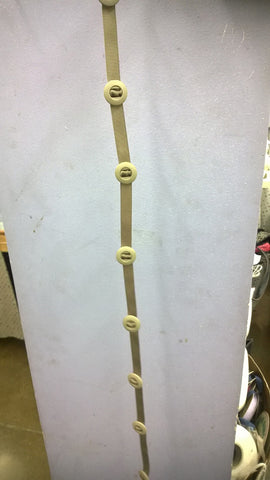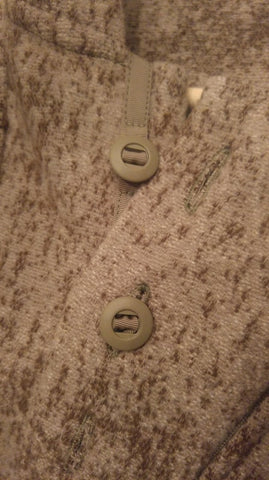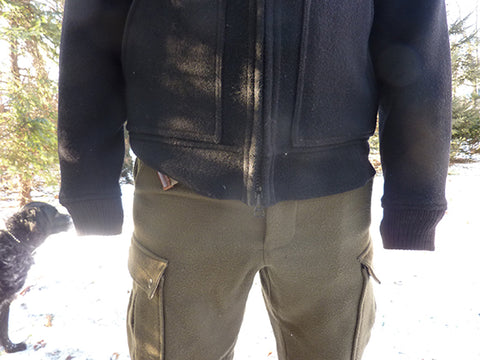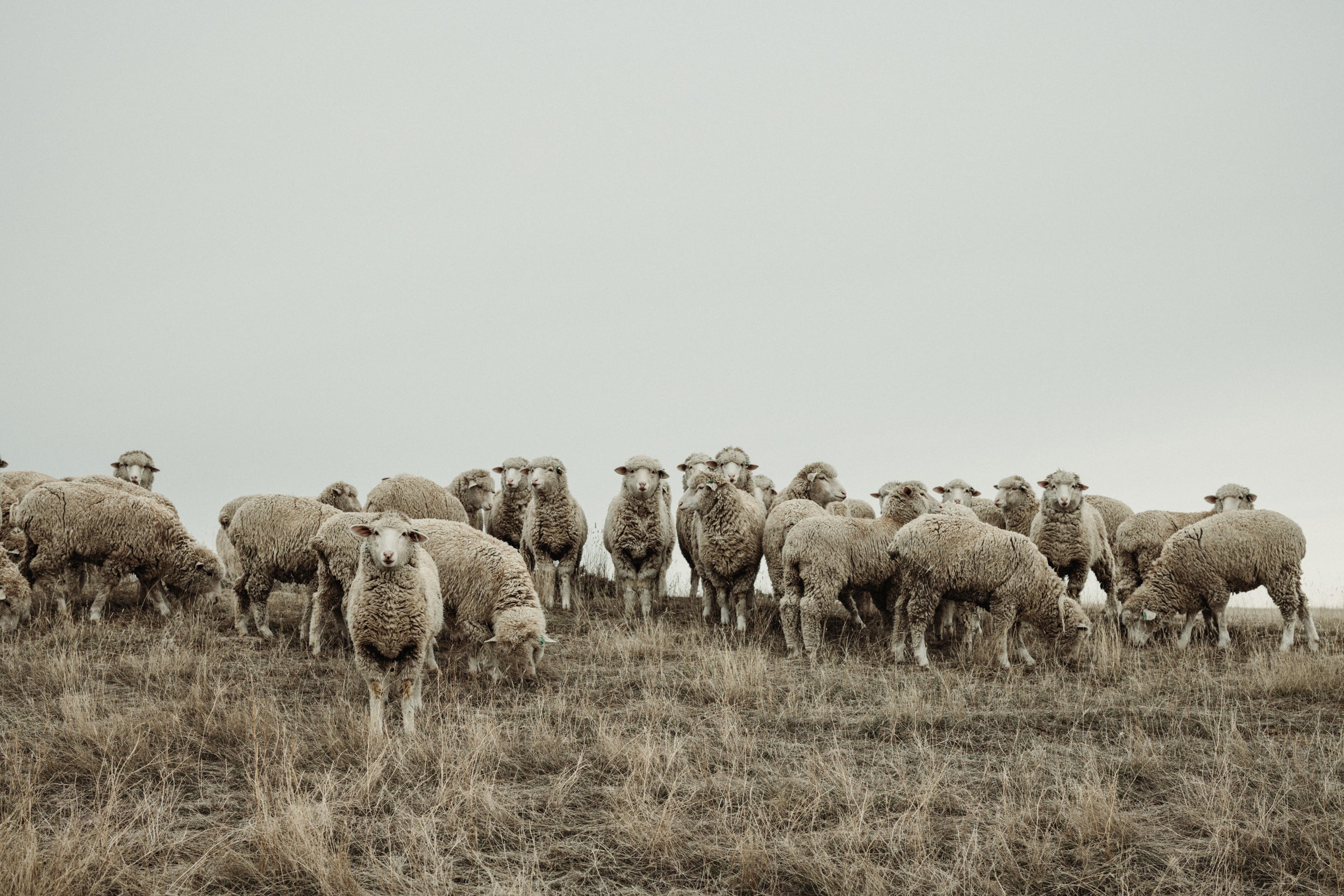The Details
Please Note: This is actually an old page and we are replacing the contents with individual pages that address each subject. But until I find and update all the links this page needs to stay here! --- Ralph
The Details of our construction include specialized buttons, zippers, thread, cuffs, fasteners, combination fabric, Mouton Fur ... These are discussed below.
Slot Buttons
Slot buttons are far more secure than standard 4-hole buttons because Slot Buttons are attached by a strip of nylon that runs through the slots in the buttons. The nylon strip is sewn to the garment, as shown below:

Advisor Mike Dean was setting off on a weeks-long snowshoeing trip in Northern Maine. It was cold, but Mike had a long way to go, and he was pulling a 150-pound (68 kg) toboggan, so he wore his MidWeight Anorak and strapped his All-Around Jacket to the webbing of the toboggan. He had not been underway very long when he stopped to check the load, and was surprised to find his All-Around Jacket had been dragging in the snow beside the toboggan for about 250 yards (230 meters). The jacket had somehow slipped free of the lashings, but a single Slot Button had hooked onto the webbing, preventing loss of the Jacket. The Jacket was full of snow, having turned into a tiny snowplow, but was not damaged at all ... not even where the Button was attached. Loss of the Jacket would have been a very serious problem.
"Simply the most durable product on the planet. At US Button we make an item that is the superman of the industry. Our buttons can withstand fire, high impact, thousands of washings and, up to this moment, anything else that's been thrown at them. The resins that we use are time tested and of the finest and most consistent grade. It's no small wonder why we sell our buttons to companies that demand durability, quality, and reliability. As an added bonus we were able to employ a staff and factory here in the USA ... not an easy task in today's world.” Burt Elliot, Operations Manager, Emsig / US Button
 A small part of the Button Room at US Button's NYC Showroom
A small part of the Button Room at US Button's NYC Showroom
It is kind of amazing devoting a page on our website to BUTTONS. But like just about everything in this world, it turns out that there is far more to buttons than we ever suspected.
Our philosophy at WeatherWool is to always do whatever we can to improve the quality of our products. In 2014 or so, a customer told us about Slot Buttons. We contacted Russell Breiter, whose career is BUTTONS. We think of Russell as THE BUTTON KING. In the picture below, Russell is showing us his Button Sample Racks ... each of the boxes you see contains a gross or two of a different type of button. And there are THOUSANDS of those boxes in that room, located in the Garment District of New York City.

Russell knew all about Slot Buttons, and fortunately for WeatherWool, US Buttons makes them in the USA ... and they make them from Melamine ... the best material from which to make Buttons.
“The new slotted button is the newest addition to our product line. This button will make any garment it goes on a true winner," said Bert. We fully agree. Once we investigated Slot Buttons, we knew they were our Buttons going forward.
You can see Slot Buttons below. Instead of attaching the button to the garment via thread, the Slot Button is attached to a strip of extremely tough Mil-Spec nylon fabric. The nylon runs up through one slot of the button and then down through the other slot of the button. The nylon fabric is sewn to the garment on either side of the button.
 In the picture above, the Slot Buttons have been arranged on the Nylon Binding Tape (military grade) with spacing that must match the button holes. The Fabric strip will next be sewn to the garment. Attaching buttons in this fashion is far more labor-intensive than standard buttons, but the extra security is well worth it. You are only as good as your weakest link.
In the picture above, the Slot Buttons have been arranged on the Nylon Binding Tape (military grade) with spacing that must match the button holes. The Fabric strip will next be sewn to the garment. Attaching buttons in this fashion is far more labor-intensive than standard buttons, but the extra security is well worth it. You are only as good as your weakest link.
 Above, Slot Buttons in place on the Placket of Al's Anorak. One button is closed, and one is open.
Above, Slot Buttons in place on the Placket of Al's Anorak. One button is closed, and one is open.
Below, Slot Buttons are shown on our All-Around Jacket. In the picture you can see slot buttons securing the Flap over the Cargo Pocket and on the underside of the collar, where they secure the optional Double Hood and the Throat Latch. But mainly, you will notice the Slot Buttons secure the Storm Flap over the Center Front Zipper. (We added a Storm Flap to this latest generation of our All-Around Jac not only to make the Jacket warmer for the wearer, but also to help keep the Zipper warm!)
US Buttons has made a very serious commitment to the Slot Buttons; just the mold needed to make these buttons cost $28,000. For our part, the purchase price of these Buttons is about 25 times more than the typical four-hole Button ... even Four-Hole Buttons made from Melamine. Add in the labor of attaching the Slot Buttons and we figure these Buttons are probably 75 times more expensive than standard buttons (let alone the imported buttons used on most garments!). BUT they are a big improvement, and that is the end-all, be-all for us.
Thanks to Russell and Emsig / US Buttons for a great product that our customers can rely upon in some of the most demanding situations that anyone might face.
Thread
We use abrasion-resistant military hydrophobic thread. Our tailors think we are crazy for the added expense, but we don't want any weak links. There is never any cotton in WeatherWool.
Anefil Nylon Dry is non-wicking bonded nylon designed for exceptional performance and seam strength and made in the USA for the US Army. If it wasn't for the Army, American & Efird would not make this thread in America, and we'd have a real problem. As it is, it's a little tricky for us because the minimum production run for A&E is 3000 pounds ... so when the Army orders 3000 pounds, A&E makes about 30 pounds for us.
Mouton

Mouton is French for sheep. In the fur trade, Mouton refers to an extremely select pelt of a lamb that has been treated to offer some remarkable properties.
Like all WeatherWool components, our Mouton is pure American. Americans have very little appetite for the meat of adult sheep. Virtually all sheep that are raised for meat in the USA are processed as lambs at about one year old. The pelts of all these lambs are used. Those pelts that are of the very highest quality; less than 1% of all pelts, are selected for processing into Mouton.
Mouton was originally developed as an alternative to wild furs such as beaver and seal. There are several steps in the creation of a Mouton Fur. First, the lamb must grade out to ‘Mouton potential’. Only one in one hundred lambs will have the dense, soft, and uniform fleece necessary for Mouton. When the raw pelt is shipped to the tannery, it is graded again, and about 15% of the Mouton candidates are rejected at this point. Acceptable pelts are tanned, then heat treated to make the wool fibers relatively water-resistant and straight, and extremely soft and glossy. The fleece is sheared to a uniform length of 5/8 inches (1.6 cm) and dyed. Our favorite color is a rich BROWN, but BLACK, WHITE and GRAY are also available.
Wool, and therefore Mouton as well, is considered by the medical profession to be hypoallergenic.
Mouton cannot be washed, because of the leather, but does resist soiling fairly well. If necessary, it can be cleaned by professionals who launder furs.
For more complete information on Mouton, or to order a Mouton skin, please click over to the Mouton product page.
Zippers
All our zippers are American-made by YKK in the USA. Even the pulls, which is a whole other issue. There is a huge variety of zippers, many ways to configure them, different materials from which they are manufactured and even different ways they can be operated.
We use Double Zippers on the center front of all our garments except the few, such as the ShirtJac, that have only buttons. A double zip can be opened at both bottom and top, or either one, or neither. Any outdoor garment that uses a single zipper is just not a serious garment. We generally use Vislon zippers because they are more tolerant of grit and cold than metal zippers. Also, Vislon is safer because it does not conduct electricity. We have been unable to find zippers whose performance is guaranteed in temperatures below -20F/-29C, so some of our garments, such as the All-Around Jac and the SkiJac, have storm flaps partly to insulate the zippers.
- And on the topic of zippers --- here's a great short YouTube tutorial on fixing a zipper slider than is not closing the zipper teeth from Science Sir.
Knitted Cuffs and Ribs and Neck Gaiter
Our knitted cuffs, such as those on our Hooded Jackets, are custom made for us with 18 micron (a micron is a millionth of a meter) Merino yarns, knitted in a tight 2x2 pattern. We use no elastic. We needed to make our own because knitted cuffs and ribs of pure American Merino are not commercially available ... so it was either eliminate this design feature or make our own.

to great lengths to make our own cuffs, using only pure American Merino wool.
The sleeves of our Hooded Jacket are long enough that most people can pull the hands inside, pretty well eliminating the need for gloves.
Though most people don't give their cuffs much consideration, they are often the part of a jacket that fails first ... whether in the rain or just working around water. Typical cuffs are made from acrylic or cotton, and they will -- at the worst times -- get soaking wet and suck heat from your wrists, which will quickly cause your hands and fingers to lose dexterity. Wool cuffs are an extremely important detail that is generally overlooked, or sidestepped because of the expense.
For us, making ribs was an unexpected adventure. The company that made our first, sample ribs discontinued that product line without warning, but after we had already committed to the wool knit ribs. And they were the only company making pure-American knitted merino wool ribs. This left us no alternative but to make our own. Which might not seem like such a big deal, given that we make our own Fabric. But knits -- such as cuffs and ribs -- are an entirely different animal than woven fabric ... for us, it amounted to an entirely new effort. We needed a new source for the wool fiber, a new spinning company, new dyeing company, and a knitting company. And we needed to place a minimum order much larger than our actual needs. But ... we are always pure American and pure wool. So we did it.
And a happy by-product of this somewhat insane exercise was the development of our Neck Gaiter. We had to purchase about 30 times more yarn than we actually needed for the Hooded Jackets, so ... Debby figured out something to do with it. And now the Neck Gaiter has become a very-much-appreciated product by some very serious outdoor people.
Scouring (Cleaning the Raw Wool)
Scouring is the cleaning of the raw wool ... it's the processing step that comes after shearing the sheep. We now address Scouring on a separate page (part of the update of the description of our production processes).


